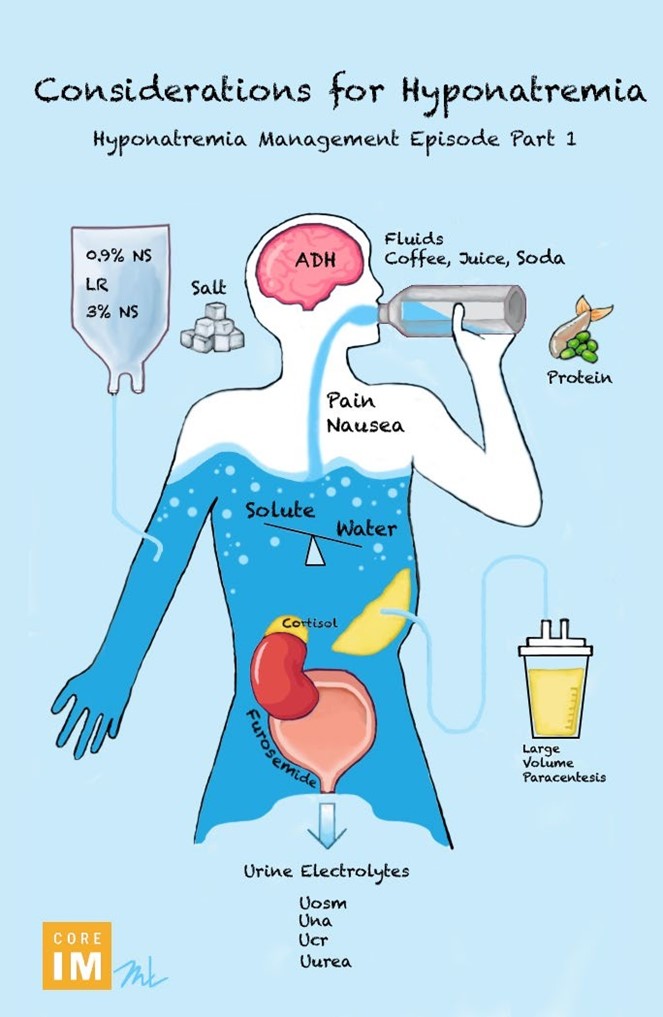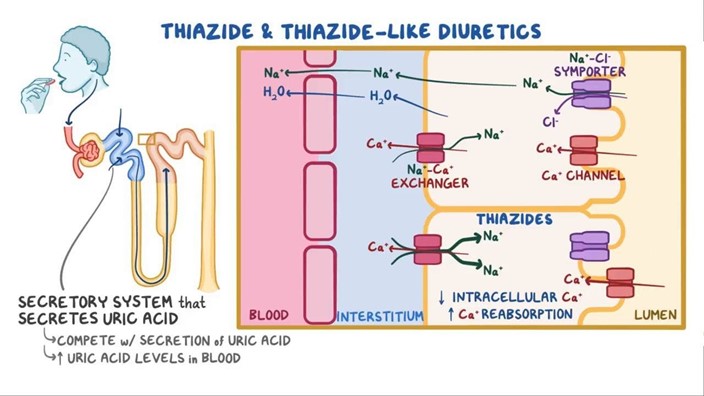An older patient comes into the clinic complaining of watery diarrhea for several days with abdominal and muscle cramping. The nurse realizes that this patient is demonstrating which imbalance?
Hyperkalemia
Hyponatremia
Fluid volume excess
Hypernatremia
The Correct Answer is B
Choice A: Hyperkalemia is not an imbalance that this patient is demonstrating, because this condition occurs when the blood potassium level is too high. This can happen in patients who have renal failure, acidosis, or excessive potassium intake. Hyperkalemia can cause muscle weakness, cardiac arrhythmias, and paralysis.
Choice B: Hyponatremia is an imbalance that this patient is demonstrating, because this condition occurs when the blood sodium level is too low. This can happen in patients who have watery diarrhea, which causes the loss of sodium and water from the body. Hyponatremia can cause abdominal and muscle cramping, nausea, confusion, and seizures.
Choice C: Fluid volume excess is not an imbalance that this patient is demonstrating, because this condition occurs when the body retains more fluid than it excretes. This can happen in patients who have heart failure, kidney failure, or excessive fluid intake. Fluid volume excess can cause edema, distended neck veins, and crackles in the lungs.
Choice D: Hypernatremia is not an imbalance that this patient is demonstrating, because this condition occurs when the blood sodium level is too high. This can happen in patients who have dehydration, diabetes insipidus, or excessive sodium intake. Hypernatremia can cause thirst, dry mucous membranes, agitation, and coma.

Nursing Test Bank
Naxlex Comprehensive Predictor Exams
Related Questions
Correct Answer is C
Explanation
Choice A: Corticosteroid is incorrect because it does not directly affect the potassium level in the blood, although it can cause sodium and water retention, which can dilute the potassium concentration. Corticosteroid is a type of anti- inflammatory medication that can be used to treat conditions such as asthma, arthritis, or allergic reactions.
Choice B: Narcotic is incorrect because it does not directly affect the potassium level in the blood, although it can cause respiratory depression, which can lead to respiratory acidosis and hyperkalemia, or high potassium level. Narcotic is a type of analgesic medication that can be used to treat moderate to severe pain.
Choice C: Thiazide diuretic is correct because it is a type of medication that increases urine output and sodium excretion, but also causes potassium loss in the urine. Thiazide diuretic can be used to treat conditions such as hypertension, edema, or heart failure.
Choice D: Muscle relaxer is incorrect because it does not directly affect the potassium level in the blood, although it can cause muscle weakness, which can mimic the symptoms of hypokalemia. Muscle relaxer is a type of medication that can be used to treat conditions such as muscle spasms, back pain, or fibromyalgia.

Correct Answer is C
Explanation
Choice A Reason: This is incorrect because phosphorus is not the most affected electrolyte by acute renal failure. Phosphorus is a mineral that is involved in bone formation, energy metabolism, and acid-base balance. Acute renal failure can cause hyperphosphatemia, which is a high level of phosphorus in the blood, due to impaired excretion by the kidneys. However, hyperphosphatemia is usually asymptomatic and can be treated with phosphate binders and dietary restriction.
Choice B Reason: This is incorrect because magnesium is not the most affected electrolyte by acute renal failure. Magnesium is a mineral that is essential for nerve and muscle function, blood pressure regulation, and bone health. Acute renal failure can cause hypermagnesemia, which is a high level of magnesium in the blood, due to impaired excretion by the kidneys. However, hypermagnesemia is rare and usually occurs in patients who receive excessive magnesium supplementation or antacids.
Choice C Reason: This is correct because potassium is the most affected electrolyte by acute renal failure. Potassium is a mineral that is vital for nerve and muscle function, especially for the heart. Acute renal failure can cause hyperkalemia, which is a high level of potassium in the blood, due to impaired excretion by the kidneys. Hyperkalemia can cause muscle weakness, cardiac arrhythmias, and cardiac arrest. The nurse should monitor the patient's vital signs, electrocardiogram, and serum potassium level, and administer medications or dialysis as ordered.
Choice D Reason: This is incorrect because calcium is not the most affected electrolyte by acute renal failure. Calcium is a mineral that is essential for muscle contraction, nerve transmission, and blood clotting. Acute renal failure can cause hypocalcemia, which is a low level of calcium in the blood, due to decreased production of active vitamin D by the kidneys. Hypocalcemia can cause tetany, seizures, and cardiac arrhythmias. The nurse should monitor the patient's vital signs, electrocardiogram, and Chvostek's and Trousseau's signs, and administer calcium and vitamin D supplements as ordered.
Choice E Reason: This is incorrect because sodium is not the most affected electrolyte by acute renal failure. Sodium is a mineral that regulates fluid balance, blood pressure, and nerve impulses. Acute renal failure can cause hyponatremia or hypernatremia, which are low or high levels of sodium in the blood, due to impaired regulation of water intake and output by the kidneys. Hyponatremia can cause confusion, seizures, and coma. Hypernatremia can cause thirst, agitation, and restlessness. The nurse should monitor the patient's fluid balance, vital signs, and serum sodium level, and administer fluids or diuretics as ordered.
Whether you are a student looking to ace your exams or a practicing nurse seeking to enhance your expertise , our nursing education contents will empower you with the confidence and competence to make a difference in the lives of patients and become a respected leader in the healthcare field.
Visit Naxlex, invest in your future and unlock endless possibilities with our unparalleled nursing education contents today
Report Wrong Answer on the Current Question
Do you disagree with the answer? If yes, what is your expected answer? Explain.
Kindly be descriptive with the issue you are facing.
